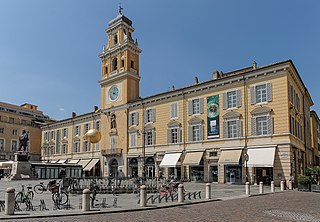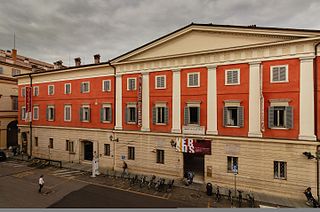This article relies largely or entirely on a single source .(June 2023) |

The Palazzo Cusani is a palace at Piazzale San Francesco #1 in the central Parma region of Emilia-Romagna, Italy.
This article relies largely or entirely on a single source .(June 2023) |

The Palazzo Cusani is a palace at Piazzale San Francesco #1 in the central Parma region of Emilia-Romagna, Italy.
The palace was constructed around 1450 by the Cusani family. It stands in front of the church of San Francesco del Prato. In 1612 the marchese Galeazzo Cusani donated the building to the Comune of Parma. In 1768, it was given to the University of Parma. Ten years later, the Duke Ferdinando di Borbone housed the Duchy's mint (Zecca) in the palace. In 1820 the duchess Maria Luigia installed the courts in the palace. From 1924 to 1983, the palace housed a middle school. The earthquake that year forced relocation of the school and reconstruction of the site.
The simple brick palace is now a library and an archive for music and theater, and is known as the Casa dell Musica, and includes an auditorium and other performance halls. The site also houses the National Institute of Studi Verdiani (National Institute for Verdi Studies). [1]

Parma is a city in the northern Italian region of Emilia-Romagna known for its architecture, music, art, prosciutto (ham), cheese and surrounding countryside. With a population of 198,292 inhabitants, Parma is the second most populous city in Emilia-Romagna after Bologna, the region's capital. The city is home to the University of Parma, one of the oldest universities in the world. Parma is divided into two parts by the stream of the same name. The district on the far side of the river is Oltretorrente. Parma's Etruscan name was adapted by Romans to describe the round shield called Parma.

Lucca is a city and comune in Tuscany, Central Italy, on the Serchio River, in a fertile plain near the Ligurian Sea. The city has a population of about 89,000, while its province has a population of 383,957.

Fabriano is a town and comune of Ancona province in the Italian region of the Marche, at 325 metres (1,066 ft) above sea level. It lies in the Esino valley 44 kilometres (27 mi) upstream and southwest of Jesi; and 15 kilometres (9 mi) east-northeast of Fossato di Vico and 36 kilometres (22 mi) east of Gubbio. Its location on the main highway and rail line from Umbria to the Adriatic make it a mid-sized regional center in the Apennines. Fabriano is the headquarters of the giant appliance maker Indesit.

Guastalla is a town and comune in the province of Reggio Emilia in Emilia-Romagna, Italy.

Palma di Montechiaro is a town and comune in the province of Agrigento, Sicily, southern Italy. Many Greek archaeological findings of Magna Graecia have been found near the town.

Fontanellato is a small town in the province of Parma, in northern Italy. It lies on the plains of the River Po near the A1 autostrada, about 20 kilometres (12 mi) west of Parma towards Piacenza.

Carate Brianza is a comune in the province of Monza and Brianza, in the Italian region of Lombardy. The city lies at an elevation ranging from 230 to 300 metres above sea level, on the Lambro river.

Pontecurone is a comune (municipality) in the Province of Alessandria in the Italian region Piedmont, located on the left bank of the Curone, about 100 kilometres (62 mi) east of Turin and about 25 kilometres (16 mi) east of Alessandria.

Colorno is a comune (municipality) in the Province of Parma in the Italian region Emilia-Romagna, located about 90 kilometres (56 mi) northwest of Bologna and about 15 kilometres (9 mi) north of Parma.

The Ducal Palace, also known as Reggia di Colorno, is an edifice in the territory of Colorno, Emilia Romagna, Italy. The palace we see today was refurbished by Francesco Farnese, Duke of Parma in the early 18th century on the remains of a former castle.

The Palazzo della Pilotta is a complex of edifices located between Piazzale della Pace and the Lungoparma in the historical centre of Parma, region of Emilia Romagna, Italy. Its name derives from the game of pelota played at one time by Spanish soldiers stationed in Parma.

The Certosa di Parma is a former Carthusian Monastery located in the outskirts of Parma.

San Francesco del Prato is a Gothic-style, Roman Catholic church, located on Piazzale San Francesco #4 in central Parma, Italy. In front stands the 15th-century Palazzo Cusani.

The Villa Traversi Tittoni, or Villa Cusani Traversi Tittoni is a rural palace in Desio, northern Italy.
San Pietro is a Roman Catholic church in central Piacenza, Emilia Romagna, Italy. The church was built over the site of an ancient church titled San Pietro in Foro.

The Gazzola Institute is a school of the arts and art museum, located on via Gazzola n°9 in the town of Piacenza, region of Emilia Romagna, Italy.

The Casino Mediceo di San Marco is a late-Renaissance or Mannerist style palace located on Via Cavour number 57 and via San Gallo in Florence, region of Tuscany, Italy.

The Palazzo Santa Margherita is a Neoclassical-style palace located on Corso Canalgrande #103 in the central Modena region of Emilia-Romagna in Italy.

The Palazzo del Giardino or Palazzo Ducale del Giardino is a historic palace in the Parco Ducale in Parma. It is not to be confused with the official Parma residence of Marie Louise, Duchess of Parma between Palazzo della Pilotta and Palazzo della Provincia in what is now known as piazzale della Pace - she also lived at the Ducal Palace of Colorno and in the Casino dei Boschi in Sala Baganza. The main Ducal Palace in Parma, the Palazzo della Pilotta and the Reinach Theater were all destroyed in an early morning air raid on 13 May 1944, carried out by the 465th Heavy Bombardment Group of the US Airforce, 781st Squadron, which dropped 9 GP bombs on the city centre.

The Palazzo Gravina-Cruyllas is a palace located on the corner of Piazza San Francesco and Via Vittorio Emanuele, in the center of the city of Catania, Sicily, southern Italy. Vincenzo Bellini was born here, and the site now houses a museum dedicated to the opera composer: the Museo Civico Belliniano. The entrance stands across the piazza from the Monument to Blessed Giuseppe Dusmet and the church of San Francesco d'Assisi all'Immacolata.
44°48′18″N10°19′59″E / 44.8050°N 10.3331°E